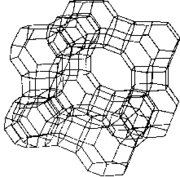Weisz, Paul B.

| Topics: |
While working at Mobil Oil, Paul Weisz (1919– ) pioneered the use of natural and synthetic zeolites (hydrous silicates) as catalysts. These catalysts are highly selective, facilitating only certain reactions between specific molecules of given shapes. Processes based on zeolite catalysts were first developed in the 1960s and were found to increase both the amount of gasoline obtainable from petroleum and the octane rating of gasoline. Shape-selective zeolite catalysts proved to be widely applicable to many other industrial processes, including the manufacture of gasoline from natural gas and the production of raw materials for making polyester garments, plastics, and other products from petroleum.
Weisz, who grew up in Berlin, knew from an early age that he wanted to be a scientist and go to America. As a radio "ham," who at the age of 16 had published articles in a radio journal, Weisz managed to get a summer job with Telefunken, a major radio and electronics company; he later interned at the Cosmic Ray Institute after being turned down by Otto Hahn and Lise Meitner's institute because those scientists were working on "classified" research. Meanwhile, his goal of coming to the United States was still out of reach—Weisz had no American relatives and Germany banned the export of monetary funds. But at age 16 Weisz wrote to three American universities offering his family's support of an American wishing to study in Germany in exchange for similar support for him in the United States. Such an exchange was worked out through Auburn University (formerly Alabama Technical University). He arrived in Alabama in 1939, narrowly escaping the outbreak of war. Having interrupted his graduate work in Berlin, Weisz completed the credits for a bachelor's degree in less than one year. He then continued research on cosmic radiation at the Bartol Research Foundation of the Franklin Institute in Swarthmore, Pennsylvania. After the United States entered World War II, Weisz, a longtime radio enthusiast, became an electronics engineer, teaching Signal Corps trainees first at Swarthmore College and later at the Radiation Laboratory at the Massachusetts Institute of Technology, where they were participating in the development of LORAN, or long-range aid to navigation, based on radio signals.
Not until after he had become a well-established researcher in catalytic chemistry did Weisz achieve his long-deferred goal of a doctoral degree at the Eidgenössische Technische Hochschule in Zürich, Switzerland, while on a leave of absence from Mobil. His thesis on the mechanism of dyeing fibers developed some of the basic laws about the entrance of dyes into fibers, based on his experience with the velocity with which chemicals flow into catalytic materials.
After retiring from Mobil, Weisz began yet another career—applying general chemical and physical principles to biomedical research. He designed (and Madeleine Joullié and one of her students at the University of Pennsylvania synthesized) molecules that mimic some of the healing properties of heparin but that do not exhibit heparin's potentially dangerous anticoagulant effects. Acting in some ways like an organic zeolite, these molecules can capture other molecules, such as cortisone. The combination of cortisone and the new molecule inhibits the proliferation of blood capillaries associated with tumor growth and some forms of blindness. Other applications are under investigation.
Further Reading